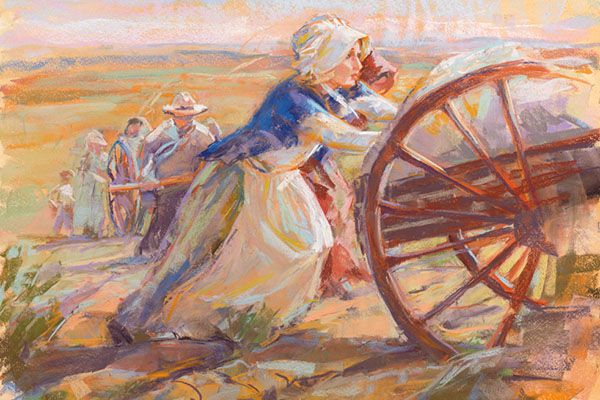Pioneer Day: From Boring to Inspiring
July 22, 2016 • Blog Post
Sprawled out on my twin-size bed and grasping the cool metallic headboard above me, I sighed with every ounce of energy I had in my 12-year-old body. “Why can’t we just go to Disneyland like normal people?” I whined to my sister. It was, after all, summer vacation. As I stared at the ceiling, I imagined myself sipping a soda and soaking up the sun in my swimming suit, the ocean only a dive away.
But a few weeks later, instead of lounging in a beach chair, I found myself stuck in the back of a 15-passenger van, heading down a dirt road in the middle of nowhere. Along our two-week drive of the Mormon Pioneer Trail from Nauvoo, Illinois, to Salt Lake City, my dad turned off the ignition and told us that this was our next stop. I looked out the window.
It was another rock.
But I got out of the car and followed my dad as he climbed a giant mound of gray stone among the wild grasses in Wyoming. Bending down low, he reverently pointed to the faint, white scratches flitted across the rock’s surface.
“These are the names of the pioneers,” he told us.
After Nauvoo, Winter Quarters, and Chimney Rock, I knew that the pioneers had lived. But there was something about that windy spot in the American West. Those people—those names—were suddenly real to me in a way that they hadn’t been before, and their faith in traveling that wearying trail finally hit home.
Years later, I have wondered if I could have done what the pioneers did. Would I have made it to Independence Rock and written my name there—proof that I loved God more than the world He asked me to leave behind? As a sixth grader, driving in a car for weeks felt like a long and arduous journey, and even now, I cannot fathom walking the distance. I often wonder why the pioneers had to give up everything for the gospel when I feel that I have had to give up so little.
Renata Tonks Forste’s words in a 1997 BYU devotional provide perspective: “Today I believe that our task is in many ways as arduous as that of the early Saints,” she says. “The path we walk, however, is not a physical trail broken through frontier lands—it is a personal path that we must each find and follow.”
Just as the pioneers packed up their wagons to take the path that God prepared for them, we must also leave behind our desires and follow God’s will for us. Our journeys can be physical and spiritual and philosophical and emotional and confusing.
However, William Clayton promises that we can conquer any path laid before us. “If you will be faithful,” he says in a letter to his friends, “you have nothing to fear from the journey. The Lord will take care of his saints.”
That’s not to say that we won’t feel weary or perhaps even despair by the end of the day. The Lord never promised us that we wouldn’t get our hands dirty while figuring out where He wants us to be. Instead, He promises us that as we humble ourselves and walk beside Him, He will “reveal to us the purposes and mysteries that [He] holds for each of us.”
—Danielle Christensen, BYU Magazine intern




